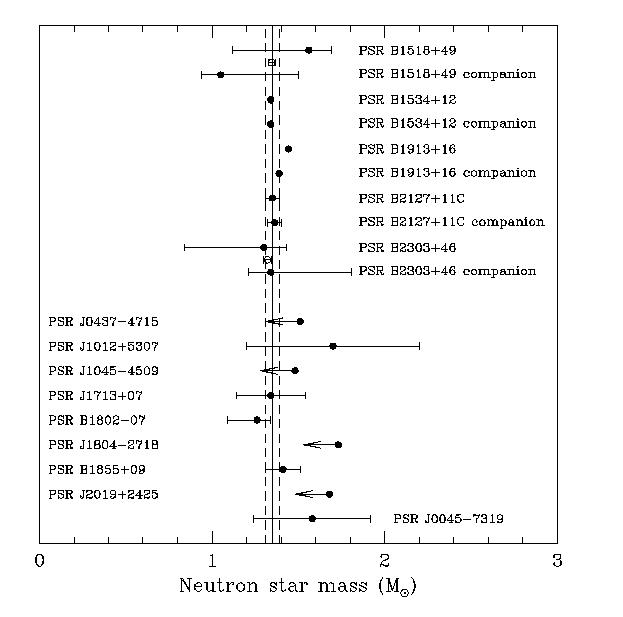 Neutron star masses from Max Camenzind.
Neutron star masses from Max Camenzind.
| MadSci Network: Astronomy |
There are two issues here. One is the question of how to produce a supernova and the other is how to produce a black hole. Both are the subject of intense research and speculation right now in astrophysics. Arnett is more worried about how to explode a star to produce a supernova, and less worried about black holes. That's why you can't find the answer on his book. One thing to take into account is that current theories on stellar structure have difficulty explaining why stars explode and whether those explosions produce black holes. Therefore we don't know yet how to make black holes. A stellar iron core will collapse into a neutron core. Somehow during that collapse, an explosion is produced that blows out the outer parts of the star and leaves the neutron core alone, as a new neutron star. The maximum mass of a neutron star is uncertain because we don't know the equation of state of neutron matter, but as you say, an upper limit may be around 3 solar masses. I tend to side with the lower limit of 1.5 solar masses because observations (see the figure) and detailed calculations of neutron stars that take into account rotation and other effects tend to favor lower values. Norman K. Glendenning at the Lawrence Berkeley National Laboratory estimated a theoretical maximum mass of around 1.5 solar masses for a neutron star ( Physical Review C, Vol. 64, Article 025801 (2001)). The highest neutron star mass is 1.7 solar masses, but this measurement has a large possible error. The true mass for this star, known as PSR J1012+5307, could be anywhere between 1.15 and 2.2 solar masses. Strikingly all measured neutron star masses cluster around 1.4 solar masses as shown in the diagram below, taken from Max Camenzind's site at:
http://www.lsw.uni-heidelberg.de/users/mcamenzi/NS_Mass.html
This means that neutron stars always form with nearly the same mass. Just another puzzle for astronomers to solve!
 Neutron star masses from Max Camenzind.
Neutron star masses from Max Camenzind.
The first conclusion here is that not every supernova must produce a black hole. If the star explodes as a supernova, it may leave behind a neutron star —and there's plenty of them out there— as a happy ending for the supernova.
If the neutron core increases its mass further than the maximum neutron star mass, it may collapse into a black hole, or it may turn into a hitherto unknown state of matter that can withstand collapse. We just don't know. Such increase of mass may happen if there is no supernova explosion, but instead the outer layers of the star fall onto the neutron core, a possibility that you already considered in your question (see the article by O'Connor and Ott in http://arxiv.org/abs/1010.5550 for example).
Here comes the issue of the supernova mechanism. There are several ideas on this question. Arnett and Schramm (The Astrophysical Journal, Vol. 198, p. 629 [1975]) proposed that the external layers of the star are blown out by the neutrinos produced during the collapse of the iron core. Van Riper (The Astrophysical Journal , Vol. 257, p. 793 [1982]) proposed that the collapsing stellar core bounces back and pushes out the outer envelopes, producing a supernova explosion. It is this bouncing of the core that may produce a black hole. The iron core collapses catastrophically. When it reaches nuclear matter densities, it bounces. It may then happen that the core changes its properties in such a way that the maximum mass becomes smaller after the bounce, and a collapse into a black hole follows (see Baumgarte, Janka, Keil, Shapiro, and Teukolsky, The Astrophysical Journal, Vol. 468, p. 823 [1996]). All this has plenty of speculation of course. I recommend the book by Shapiro and Teukolsky, Black Holes, White Dwarfs, and Neutron Stars, Wiley-Interscience (1983), especially chapter 18 for further reading.
Greetings from,
Vladimir Escalante Ramírez
Center for Radio Astronomy and Astrophysics
National University of Mexico, Morelia, Mexico
Try the links in the MadSci Library for more information on Astronomy.